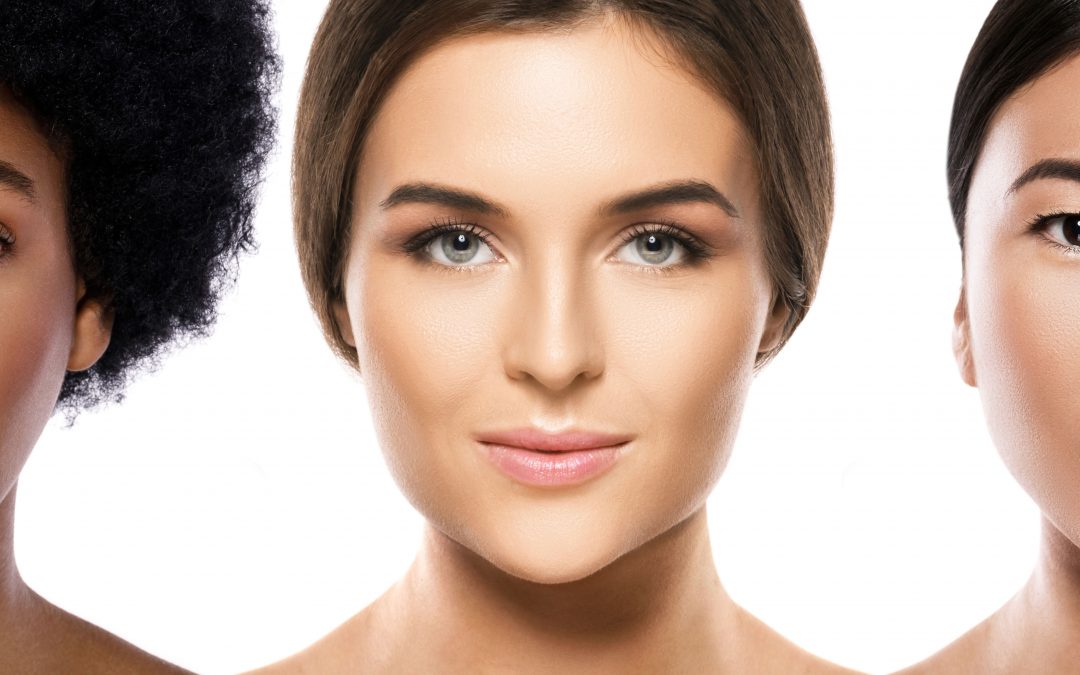Sun exposure and inflammation can trigger the formation of dark spots and patches that lead to an uneven skin tone that can make you look older. But, does the skin phototype and inherent color play a role in the apparition of these blemishes? Yes, they do. Different skin colors contain different amounts of melanin and different proportions of eumelanin and pheomelanin, which determine the tone of the patch. The darker your skin tone is, the more melanin your skin can produce, so darker skin tones are more prone to develop hyperpigmentation than fair skin tones.
MELANIN, EUMELANIN AND PHEOMELANIN
The color of our skin is determined by genetic factors, we inherit it from our parents and other ancestors. The pigment that gives these beautiful colors to our skin, hair, and eyes is called melanin. Inside the skin, this melanin is produced by specialized skin cells called melanocytes. The main role of melanin is to absorb and scatter UV radiation, thus helping to protect human cells from the mutagenic effects of UVR. Therefore, our melanocytes increase melanin production when sun-exposed and, if continuously exposed, these can unevenly multiply in the most vulnerable skin areas and constantly overproduce melanin, leading to an uneven skin tone. Melanin overproduction also occurs as a response to hormonal changes, inflammation, or wound healing. For this reason, pregnant women, people with acne, and inflamed or scarred skin areas are more susceptible to overproduce melanin and develop skin patches and should be better-protected when sun exposed.
Diversity in skin color and the tonality of skin patches is not only determined by the number of melanocytes and how much melanin they produce but also by the percentage of the different types of melanin they produce. There are two types of melanin, eumelanin and pheomelanin.
• EUMELANIN: These are black and brown pigments. Darker skin tones show a higher rate of eumelanin and lower rates of pheomelanin. Eumelanin has shown to be more effective in protecting the skin against the damaging effects of UVR than pheomelanin, and it is also a good free radical scavenger.
• PHEOMELANIN: Pheomelanin is made of red and yellow pigments. Fair skin phototypes tend to produce more pheomelanin and very low (or none) rates of eumelanin. It explains why freckles or patches in fair skin types show a reddish or yellowish tone.
To sum up, the amount of melanin, and the percentage of eumelanin and pheomelanin that human skin produces is what determines every different skin tone, as well as the different shades of dark spots or skin patches. To learn more about the different types of pigmentation problems you can check out our former post Skin Hyperpigmentation.
According to this, darker skin tones are more vulnerable to suffer hyperpigmentation but, at the same time, their skin offers better protection against sunburn, skin cancer, and some other UVR-induced problems such as wrinkles and folds. On the other hand, fair skin types show fewer pigmentation problems, and when they appear, they present a yellow/reddish tonality. Nevertheless, fair skins are more prone to suffer sunburn and other and more severe photodamage. So the lighter your skin is, the more you have to protect it from sun damage using a good sunblock.
At this time of the year, it is very common to find out that some discoloured skin patches have appeared. If that is the case, don’t worry, nowadays there are multiple treatments that can effectively remove them. In this regard, we highly recommend you check out the MELINE® product range, as they offer a very comprehensive range for every skin type.
MELINE TREATMENTS APPROACH EVERY PIGMENTATION PROBLEM ACCORDING TO THE ETHNICITY OF THE PATIENT AND THE PART OF THE BODY AFFECTED
The skin tone or Skin Phototype is not the only determinant factor in the formation of hyperpigmentation, the other three are:
• Type of hyperpigmentation.
• Triggering agent.
• Part of the body affected.
MELINE® is the only brand of aesthetic products specifically specializing in the treatment of pigmentation problems. As such, they know the importance of treating these alterations taking all these four factors into account.
The brand offers a specific approach that has shown very effective results. MELINE® range of products includes professional solutions and home skincare products to comprehensively treat the skin, starting at the doctor’s office and finishing with a follow-up at home.
You can learn more about MELINE® following this link.
Here we briefly present you MELINE®’s flagship product for the treatment of the most common type of dark patches, melasma.
MELINE® CAUCASIAN SKIN & MELINE® ETHNIC SKIN
For the treatment of dark patches, MELINE® proposes treating fair skin types (phototypes I-III), and darker skin types (phototypes IV-VI) separately. To that end, they have created two lines composed of 3 products each. Both lines, CAUCASIAN SKIN and ETHNIC SKIN, are composed of a professional solution, a serum, and a night cream, but they are made of different active ingredients according to the needs of every different skin phototype:
• MELINE® 01 Caucasian /Ethnic Skin: Soft peel to be applied by the professional in the office.
• MELINE® 02 Caucasian/Ethnic Skin Day: Morning serum to reduce pigmentation and melanin deposits.
• MELINE® 02 Caucasian/Ethnic Skin Night: Night emulsion that modulates melanin production thus preventing rebound effects.


